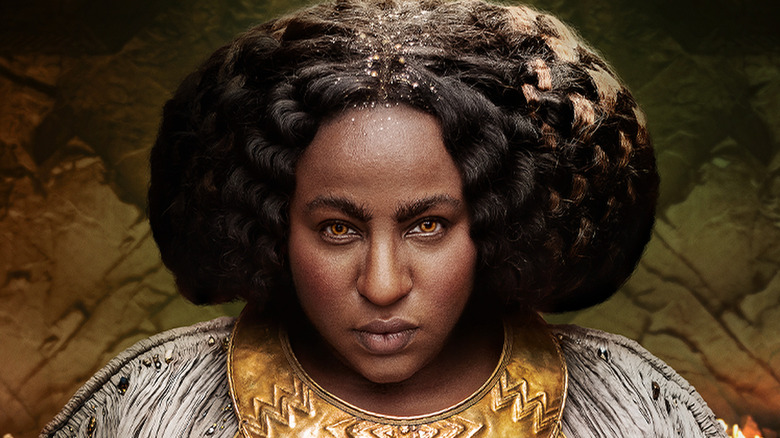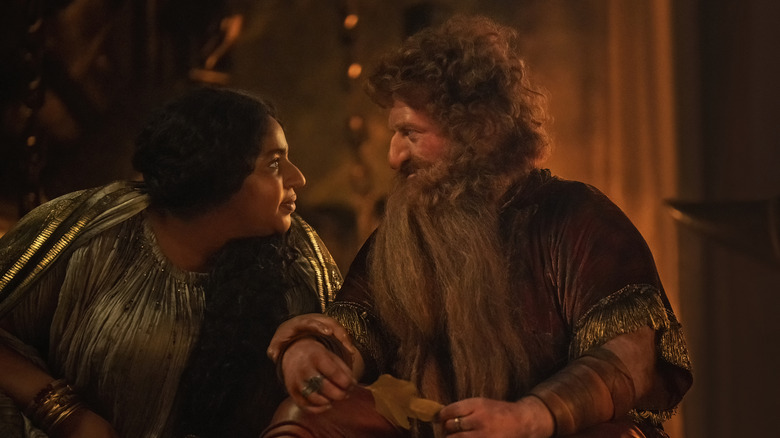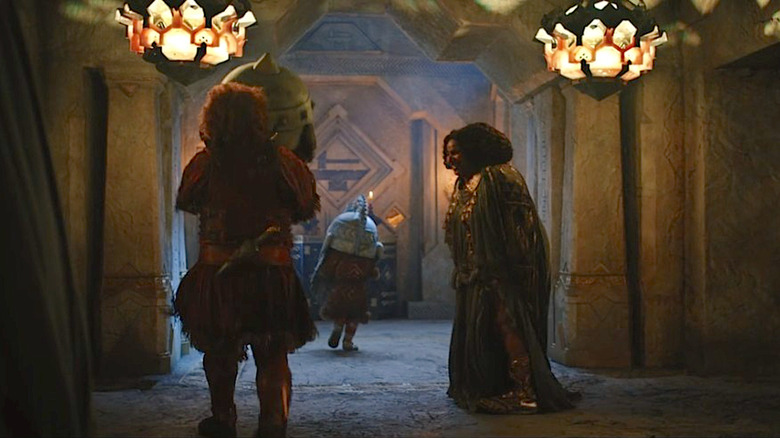After The Rings Of Power Episode 4, It's Time To Talk About The Dwarf Women Of Middle-Earth
Dwarves have always been part of the Middle-earth mantra. Tolkien's "Stunted People" play an integral role in "The Hobbit" story. Gimli is a member of "The Fellowship of the Ring." Even in "The Silmarillion," which is told from an Elvish perspective, Dwarves show up ad-nauseam throughout the text.
While Dwarves can be found across Tolkien's world, though, there's always one element that's missing: the female touch. Dwarf-women are famous for remaining out of sight. In fact, the appendix of "The Return of the King" says, "It was said by Gimli that there are few Dwarf-women, probably no more than a third of the whole people. They seldom walk abroad except at great need."
This hidden aspect of the "other half" (or more accurately, other third) of the Dwarven population means the only way to really see them in action is to go right into the hidden, subterranean dwellings of the Dwarves when they're teeming with life, something that has never been done on screen — until now.
"The Lord of the Rings: The Rings of Power" has spent copious amounts of time in its first season exploring the subterranean Dwarven mansion of Khazad-dûm, and in the process, we've gotten to see several Dwarf-women up close and personal, especially Princess Disa. Throughout this process, we've finally been able to catch a glimpse of an adaptation of Tolkien's famously secretive Dwarf culture, including its women, and so far, it lines up with the scant source material pretty darn well.
Dwarf-women and relationships
There is very little in Tolkien's writings about female Dwarves. Even so, the two paragraphs or so that exist provide an insightful snapshot of their personalities and priorities. The first is in "The Return of the King" appendix, as noted above. That text goes on to describe Dwarf-women as looking very similar to men. We'll leave the beard question alone for now, but suffice it to say that it's an issue that's open for debate.
Regarding marriage, the text says that Dwarvish populations grow slowly due to the fact that the men outnumber the women two to one. It adds, "For Dwarves take only one wife each in their lives, and are jealous, as in all matter of their rights." This dynamic was reflected in Episode 4 of "The Rings of Power" when Disa immediately shrugs off the idea of Durin having a "wee girlfriend." The response is one of a partner completely confident in the loyalty of their spouse. It's a level of trust that Durin clearly reflects when the two Dwarven lovers joke about intimate things on the bridge in Khazad-dûm later on, too.
Interestingly, the text also says that, while loyal when married, not every Dwarf-woman chooses to tie the knot. "For not all the women take husbands: some desire none; some desire one that they cannot get, and so will have no other," it reads. The book "The Peoples of Middle-earth" builds on this concept, adding the note that female Dwarves are never forced to marry against their will (and that it would be impossible to try). Add all of it up, and you get a picture of strong-willed Dwarf-women who marry selectively, are loyal to their partners, and are critical to the survival of their race.
Dwarf-women as nurturers
Along with being the better half of Durin IV, Disa's presence in "The Rings of Power" has also helped to provide an interesting interpretation of what Dwarf life could look like. A major element of this revolves around her presence and responsibilities as a mother to two troublesome children. We've already seen Disa scolding her kids in multiple episodes — and it turns out that this is another element lifted straight from Tolkien's pen.
"The Peoples of Middle-earth" includes a couple of notes on Dwarf-women and their familial life. It says that all Dwarves marry later in life and don't have a lot of children (four kids is a rarity). It goes on to say, "To these they are devoted, often rather fiercely: that is, they may treat them with apparent harshness (especially in the desire to ensure that they shall grow up tough, hardy, unyielding), but they defend them with all their power, and resent injuries to them even more than to themselves."
This image of a harsh, stern, loving parent fits well with the stoic yet close-knitted underground life of the Dwarves. It's a hard line to walk balancing so many vague but bold elements. And yet, so far, "The Rings of Power" seems to be pulling it off with the help of solid writing, stellar acting, and plenty of special effects to really bring the Dwarven homefront to life. It's yet another novel and exciting thing fans can look forward to as the second half of Season 1 races toward its conclusion.
"The Lord of the Rings: The Rings of Power" is streaming on Prime Video. The series premiered in early September, and new episodes drop every Friday at 12 a.m. for the remainder of its eight-episode 1st season.


